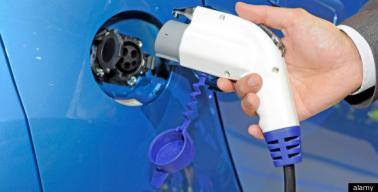
By Lynne Peeples
No villains appear in Chris Paine”s new film, “Revenge of the Electric Car” — a stark contrast to its 2006 predecessor. “Who Killed the Electric Car?” came complete with a search for the discarded bodies of General Motor”s EV1 (eventually found crushed in a junkyard), a funeral and accusations that the auto industry and oil compani
es had teamed up to destroy the promise of a zero-emission vehicle.
But Paine had a feeling the electric car would eventually come back. As he told HuffPost, “You can”t really kill a great idea.”
In the new film, which debuted in select cities on Friday, Paine goes behind the scenes with executives of GM, Nissan and start-up Tesla Motors, as well as a quirky couple that do their own gas-to-electric car conversions, in a race to produce a viable version of the plug-in car. And the carmakers appear to be pleased with Paine”s finished product: GM”s Bob Lutz, the arch-villain of the previous film, comes off as decent guy, and Nissan and Tesla are reportedly sponsoring screenings.
What”s changed since Paine”s first film? A few things. For starters, when the EV1 debuted in the late-1990s, gasoline was cheap, Paine said. Today”s high prices provide a drastically different backdrop. Still, victory for the zero-emission electric car is far from a given.
In the early 1900s, the first battle played out between the electric and gas vehicle. The latter may have won out partly because of stereotypical male preferences: “It was noisy and made them sound like wild animals,” said Paine.
Gas cars went on to hold a monopoly for the next 100 years. But, as Paine suggests, that”s finally starting to change — along with what society considers sexy. “The good news about electric cars is that they are both more masculine and more feminine,” he added. “They are more powerful. You feel like you”re driving an iPad or something.”
The sub-100 mile range of some current electric vehicles also discourages some buyers, especially those living outside of cities. Cars such as the Chevy Volt, fitted with a gas engine that kicks in when the battery dies, may remain more practical.
But a broad charging network could soon diminish any remaining reliance on gasoline. The Northeast Electric Vehicle Network announced last Wednesday that it will help push the installation of charging station infrastructure throughout the region. Similar programs are underway around the country. (California alone already has more than 500 stations.) What”s more, by the end of next year, Tesla is expected to release its Model S, which will boast a range of up to 300 miles.
Then there”s the popular criticism that oil is still required, albeit indirectly, to charge gas-less cars. Paine scoffs at that argument, pointing out that the world”s biggest user of electricity is the oil industry.
“Every gallon of gasoline takes like five kilowatt hours of electricity to make. That”s why power lines are going into refineries, not coming out,” he said. “If you took that same energy and put in an electric car — a Leaf for example — it could go 20 miles.”
Hybrid and all-electric cars also tend to carry a higher price tag than traditional gas-powered cars, although Paine suggests that they “aren”t as expensive as people think.” The federal government currently offers a $7,500 rebate, bringing options down to the $30,000 range. Plus, swapping a gas pump for a plug essentially cuts costs by two to three dollars a “gallon,” according to Paine.
In an interview with HuffPost in August, Ryan Park, director of business development for California-based REC Solar, suggested that pairing solar panels with electric cars could stretch savings even further, with the cost of driving a mile becoming 80 percent less than it would in a gas-powered car.
Better yet, “none of that money goes to the Middle East,” said Paine. “What if we kept that money here? We could build a light rail station every day.”
Article courtesy of huffingtonpost.com

